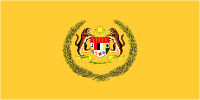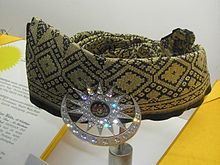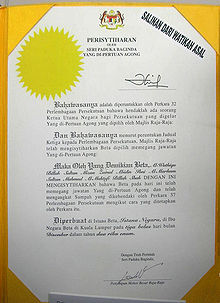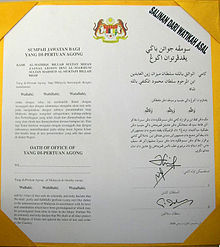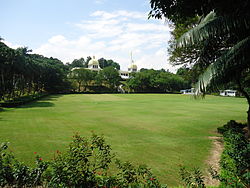- Yang di-Pertuan Agong
-
Yang di-Pertuan Agong of Malaysia Monarchy Federal 
Arms of His Majesty the Yang di-Pertuan Agong of MalaysiaIncumbent:
Mizan Zainal Abidin
the Sultan of TerengganuStyle: His Majesty First monarch: Tuanku Abdul Rahman
of Negeri SembilanFormation: 31 August 1957 Malaysia 
This article is part of the series:
Politics and government of
MalaysiaMonarchy
The Yang di-Pertuan Agong is the head of state of Malaysia. The office was established in 1957 when the Federation of Malaya (now Malaysia) gained independence.
A literal English translation of the title is "He who is made Lord". However, common alternatives are "King", "Supreme Ruler", "Paramount Ruler", or "Supreme Head of State". Malaysia is a constitutional monarchy with an elected monarch as head of state. The Yang di-Pertuan Agong is one of the few elected monarchs in the world.
Since 1993, the full title in Malay has been, Seri Paduka Baginda Yang di-Pertuan Agong (His Conqueror Majesty The Supreme Lord of the Federation). Prior to that, the honorific Ke Bawah Duli Yang Maha Mulia (The Dust Under The Feet Of His Majesty) was also used. The consort of the Yang di-Pertuan Agong is called the Raja Permaisuri Agong (Queen Lady Consort). The couple are addressed in English as "His Majesty" and "Her Majesty".
In Malaysia's constitutional monarchy, the role of the Yang di-Pertuan Agong is largely ceremonial. The constitution specifies that the executive power of the Federal government is vested in the Yang di-Pertuan Agong and is exercised by him on the advice of the federal Council of Ministers. The latter is headed by the Prime Minister, appointed by the Yang di-Pertuan Agong from among the elected members of Parliament.
The 13th and current Yang di-Pertuan Agong is Sultan Mizan Zainal Abidin, the Sultan of Terengganu. His reign began on 13 December 2006 after his election by the Conference of Rulers. He was formally enthroned on 26 April 2007.[1] Sultan Abdul Halim of Kedah has been elected to succeed him from 13 December 2011.[2]
Election of Yang di-Pertuan Agong
The Yang di-Pertuan Agong is formally elected to a five-year term by and from among the nine Rulers of the Malay states (nine of the thirteen states of Malaysia that have hereditary royal rulers), who form the Conference of Rulers. The Yang di-Pertuan Agong may not be re-elected after his term has expired.
In the event of the Yang di-Pertuan Agong's death in office, the Conference of Rulers elects a new Yang di-Pertuan Agong as if the previous term had expired. The new Yang di-Pertuan Agong is elected for a full five-year term. After his term expires, the Conference holds a new election, in which the incumbent would not be re-elected.
The position de facto rotates among the nine Rulers. The selection of the Yang di-Pertuan Agong initially followed an order based on the seniority (calculated by length of reign) of each Ruler in 1957 at the Federation of Malaya's independence from the United Kingdom. The Conference of Rulers, which has the power to disqualify a candidate, has sometimes varied the original seniority order. Minors are automatically disqualified from office. After each of the nine Rulers of the states had served as the Yang di-Pertuan Agong, the order of seniority was based on the order of the states whose rulers have been elected the Yang di-Pertuan Agong.
The Conference of Rulers has met regularly since 1895. The membership of the council includes the governors or Yang di-Pertua Negeri. Only royal rulers are allowed to vote and stand for election as Yang di-Pertuan Agong.
Qualifications
- Only a royal ruler may be elected.
- Only the royal rulers may vote.
- Rulers are elected in turn.
The Constitution provides that a Ruler is not eligible for election as Yang di-Pertuan Agong if:
- The Ruler is a minor.
- The Ruler has notified the Keeper of the Rulers’ Seal that he does not wish to be elected.
- The Conference of Rulers by a secret ballot resolves that the Ruler is unsuitable by reason of infirmity of mind or body, or for any other cause, to exercise the functions of the YDP. The resolution requires at least five members of the Conference to vote in favour of it.
Election proceedings
The election is carried out by a secret ballot. The ballot papers used are not numbered, but marked with the same pen and ink, and are inserted into a ballot box. Only the Rulers participate in the election.
A Ruler may appoint another Ruler as his proxy to vote on his behalf if he is unable to attend the Election Meeting.
During the election process, the Keeper of the Rulers’ Seal distributes the ballot with only one candidate (the most senior Ruler). Each Ruler is requested to indicate whether the most senior Ruler is suitable or not to be elected as Yang di-Pertuan Agong.
The most junior Ruler, who is not listed as nominee for the office of the Yang di-Pertuan Agong, or the Yang di-Pertuan Agong is appointed to count the ballot papers together with the Keeper of the Rulers’ Seal.
The nominee must have obtained a majority of five votes before the Ruler presiding over the Election Meeting offers him the office of Yang di-Pertuan Agong. If the successful nominee declines the offer or the nominated Ruler fails to secure the required majority votes, the voting process is repeated with the nomination of the second most senior Ruler in the Seniority List of Rulers.
The process is completed only after the Ruler has accepted the offer of the office of Yang di-Pertuan Agong. The Conference declares the Ruler as the Yang di-Pertuan Agong to hold office for a term of five years. The ballot papers are destroyed in the presence of the Rulers as soon as the result of the election result is announced.
On taking office as Yang di-Pertuan Agong, he appoints a regent for the duration of his five-year term for the state which he rules. Usually, but not always, the Regent is a close relative.
See also: Installation of the Malaysian Sovereign for the installation ceremony
Order of seniority of states
After the first cycle of nine Yang di-Pertuan Agong (1957–1994), the order among the eligible, all peninsular, state rulers has followed the order established by that cycle, namely:
- the Yang di-Pertuan Besar (or Yamtuan Besar) of Negeri Sembilan (itself an elective monarchy)
- the Sultan of Selangor
- the Raja of Perlis
- the Sultan of Terengganu
- the Sultan of Kedah
- the Sultan of Kelantan
- the Sultan of Pahang
- the Sultan of Johor
- the Sultan of Perak
Four of the states of Malaysia have no hereditary royal rulers. These are Penang and Malacca in Peninsular Malaysia, and Sabah and Sarawak on the island of Borneo. These four states, along with Malaysia's three federal territories, never supply the Yang di-Pertuan Agong.
Timbalan Yang di-Pertuan Agong
A Timbalan Yang di-Pertuan Agong (Deputy Yang di-Pertuan Agong) is elected by the same process immediately after the Yang di-Pertuan Agong. The Timbalan Yang di-Pertuan Agong exercises the functions of the head of state during the Yang di-Pertuan Agong's absence, or inability to exercise functions owing to illness or infirmity.
The Timbalan Yang di-Pertuan Agong does not automatically advance to become the Yang di-Pertuan Agong when a vacancy occurs in the office. The Timbalan Yang di-Pertuan Agong acts as the head of state before the elections of the new Yang di-Pertuan Agong and Timbalan Yang di-Pertuan Agong.
Roles
The Yang di-Pertuan Agong's role is that of a constitutional monarch. The Federal Constitution and Parliamentary Acts made in accordance with it define the extent of his powers as the Federal Head of State. The executive power of the federal government is vested in him.
The monarch's powers are basically divided into two broad categories:
- the powers that he exercises on the advice of the Prime Minister, a Minister, the Cabinet, the Conference of Rulers, or some other officer or institution; and
- the powers that he exercises at his discretion (without the consent of any other authority).
The discretionary powers of the Yang di-Pertuan Agong pertain chiefly to appointing the Prime Minister, dissolving Parliament, and calling meetings with the Conference of Rulers "concerned solely with the privileges, position, honours and dignities of Their Royal Highnesses." Under the Westminster System, the Yang di-Pertuan Agong is expected to appoint a Prime Minister who will command the confidence of a majority of the elected lower house of Parliament, the Dewan Rakyat. Should the Prime Minister be or become unacceptable, he may be forced out by a vote of no confidence, which would require the Yang di-Pertuan Agong to appoint someone else. Conventionally, the Prime Minister is the head of the party with a majority in Parliament. Since independence in 1957, this has been the Barisan Nasional (National Front, formerly known as the Alliance).
The Yang di-Pertuan Agong renews the appointment of a Prime Minister after every general election until the minister decides to step down. Whenever the Prime Minister chooses to dissolve Parliament, he calls for a general election. The Yang di-Pertuan Agong may choose to refuse a Prime Minister's request to dissolve Parliament, as one of his discretionary powers.
Residences
The official residence of the Yang di-Pertuan Agong is Istana Negara (the National Palace) located in Jalan Syed Putra in the federal capital Kuala Lumpur. Other residences include the royal retreat, Istana Melawati (Melawati Palace) in the federal administrative capital Putrajaya. It is also the venue of meetings of the Conference of Rulers (Malay: Majlis Raja-raja), which elects the Yang di-Pertuan Agong.
Appointments
The Yang di-Pertuan Agong appoints numerous high-ranking office holders in the Federation under the terms of the Constitution and various Acts passed by Parliament. The constitution established procedures for such appointments.
The Council of Ministers (cabinet)
- Prime Minister (Chairman of the Cabinet), at his discretion from among the elected members of the House of Representatives who belong to the majority party or coalition.
- Ministers and Deputy Ministers (the second in command of a Ministry), on the advice of the Prime Minister.
- Directors (in charge of the different sections in the various Ministries), on the advice of the Prime Minister.
Commissions and committees
- The Election Commission, on the advice of the Conference of Rulers.
- The Judicial and Legal Service Commission, after consultation with the Chief Justice
- The Malaysian Public Service Commission at his discretion, after considering the advice of the Prime Minister and after consultation with the Conference of Rulers.
Judges
- The Chief Justice of Malaysia, on the advice of the Prime Minister and the Conference of Rulers.
- The Chief Judge of Malaya, on the advice of the Prime Minister and the Conference of Rulers.
- The Chief Judge of Sabah and Sarawak, on the advice of the Prime Minister and the Conference of Rulers.
Senators
The Yang di-Pertuan Agong appoints 44 members of the Dewan Negara, the Malaysian Senate.
State governors
The Yang di-Pertuan Agong appoints the Yang di-Pertua Negeri (Governors), of the states of Penang, Malacca, Sabah and Sarawak, at his discretion, after considering the advice of the state's Chief Minister.
The Yang di-Pertuan Agong also appoints the Mayor and City Council of Kuala Lumpur, which is a Federal Territory.
Head of Islam
In addition, the Yang di-Pertuan Agong is the Head of Islam in the four states ruled by appointed Governors: the three Federal Territories, as well as in his own state. In this role, he is advised by the State Islamic Affairs Council in each of the States.
The Yang di-Pertuan Agong appoints the Chairman and members of each council. He also appoints the State Mufti in each of these states. There is a single Islamic Affairs Council with jurisdiction for the three Federal Territories. This council is also appointed by the Yang di-Pertuan Agong.
Duties as Commander-in-Chief
In accordance with Article 41 of the Federal Constitution, the Yang di-Pertuan Agong is Commander-in-Chief of the Federation's Armed Forces. As such, he is the highest-ranking officer in the military chain of command.
As the Supreme Commander of the Malaysian Armed Forces, the Yang di-Pertuan Agong appoints the Chief of the Armed Forces Staff, on the advice of the Armed Forces Council. He also appoints the service heads of each of the three branches of the military forces.
King's Birthday
The first Saturday of June yearly is mandated by the Malaysian Constitution as the Yang di-Pertuan Agong's official birthday.
Trooping the Colour
Trooping the Colour in Malaysia, althrough inherted from the British, has tranformed into amore grander and more Malaysian celebration on the first Saturday of June annually live on Kuala Lumpur's Independence Square, which is both open to invited guests and the general public. As the Supreme Commander of the Malaysian Armed Forces, the Yang di-Pertuan Agong takes the salute on this day together with the commanders of the three services of the Malaysian Armed Forces and the MAF Joint Command.
Here are the features that make it truly Malaysian:
- The Malaysian Royal Armoured Corps's Mounted Ceremonial Squadron plus members of the Royal Malaysian Police provide the Sovereign's Escort for the ceremony. The MCS's fanfare trumpeters sound a fanfare upon the Sovereign's arrival in the Merdeka Square Saluting Base while the MCS itself also has a motorized mounted escort troop and a lancers guard troop ready to accompany them on the way.
- Instead of being just purely a infantry activity the entire Malaysian Armed Forces go out in full participation in this parade, as seen in the 4 Guard Companies and the Ministry of Defense Combined Band participating in the ceremonial march.
- An open top Land Rover is used in the inspection segment of the parade.
- The Saluting Base in Independence Square is more longer in construction in order for more invited guests to attend the ceremony and take the salute.
- All the commands and salutes are said in Malay, like for example:
- Royal Salute-Hormat Diraja
- General Salute-Hormat Sedia
- The roles of Field Officer, Brigade Majors (the parade has two instead of 1, which is another unique feature), Adjutant and Ensigns are occupied by select officers of the Armed Forces, either Army, Navy or Air Force officers, with Armed Forces NCOs doing the jobs of Regimental Sergeants Major and Colour Sergeants. However the Deputy Brigade Major (coming from the Malaysian Army) is also the concurrent commander of the 1st parade unit, that of the Joint Escort for/to the Colours, which has 5 Sergeants Major with the rank of Warrant Officer 2 or Warrant Officer 1 while the three other units have 3 officers and 2 Warrant Officers each
- All Warrant Officers in this parade, like their British counterparts, carry pace sticks but the WOs of No.1 Guard Company (Composite) throw them to the Orderlies during the Trooping segment
- State Flypast by 5 military helicopters of the Flag of Malaysia, Flag of the Malaysian Armed Forces, and Flags of the Malaysian Army, Royal Malaysian Navy and Royal Malaysian Air Force during the performance of Negaraku, the National Anthem
- 21-gun salutes are performed during the National Anthem
- Negaraku is also performed during the colours obtainment segment by the Joint Escort for the Colors, which becomes the Escort to the Colours after the Colours Party join the Escort
All three branches of the Armed Forces - the Malaysian Army (represented by the Royal Malay Regiment or other units), the Royal Malaysian Navy, and the Royal Malaysian Air Force - participate in the Trooping, in their No. 1 uniforms. The Massed Bands include musicians from the Military bands of the Army, Navy and the Air Force, similarly in their No. 1 uniforms.
The Colours Party and the Escort for(to) the Colours also reflect the three participant Armed Forces branches. The Colours Party is composed of Ensigns, Colour Sergeants and assistant soldiers making up three Colours Parties from the Army, and there is also a single Colour Party each from the Navy and the Air Force. The Escort for(to) the Colours is a composite company, comprising an Army platoon and a squad each from the Navy and Air Force ready to receive their respective colours during the ceremony. The Parade Field Officer, Brigade Major and Adjutant are also from all the Armed Forces branches, and so too are the Regimental Sergeants-Major and Colour Sergeants.
RTM broadcasts this unique ceremony live, with the telecast starting at 7:30 in the morning with a nationwide simulcast.
Details of the Trooping
- March in of the bands
- March in of the Linesmen, Orderlies and Markers
- March in of the Parade
- Arrival of the Parade Field Officer
- Hand over of command to the FO
- Parade stands at ease in preparation
- Salutes
- Commander's Salute
- General Salute
- Ministerial Salute
- Prime Minister's Salute
- Arrival of the Sovereigns and first Royal Salute with 21-gun salute by the Royal Artillery Regiment, Malaysian Army and first State Flypast by helicopters of the Royal Malaysian Air Force carrying the Flag of Malaysia, the Armed Forces Flag and the flags of the Army, Navy and Air Force
- Parade Inspection
- Menjunjung Duli is played during the inspection by the Massed Bands.
- Trooping and Marchpast of the Massed Armed Forces Bands, in both slow and quick time
- During the quick march, a lone drummer from the Massed Bands away and goes into the No.1 Guard, and when the music stops he beats the Drummer's Call
- Trooping Proper
- Joint Escort for the Colours prepares for march after the Drummer's Call ends and when the drummer marches back to the Massed Bands. The Subaltern then takes change and all the SMs' pace sticks are removed using a single throw (another unique feature of the ceremony) and are then given to the orderlies so that they can draw and use their swords
- Join Escort marches in quick time to the Joint Colours Party
- Handover of the Royal Colours to the RSMs
- Slow March of the Colours Party happens and then the Ensigns, after saluting and drawing swords, receive their Royal Colours
- Second performance of the National Anthem (in abbreviated form)
- Joint Escort becomes the Joint Escort to the Colours, and the Colours Party join the latter
- The FO commands the parade to present arms (Before that, and the handover of the Royal Colours the parade makes way for the Joint Escort)
- Trooping of the Joint Escort in slow time, accompanied by the Massed Armed Forces Bands
- After the Colours have been trooped in slow time, the Joint Escort halts in place, turns about, and then presents arms. After this, the parade is told to shoulder arms by the FO, signalling the end of the Trooping proper
Yang di-Pertuan Agong Scholarship
In November 2006, the 10th Yang di-Pertuan Agong awarded, for the first time, the Yang di-Pertuan Agong Scholarship to ten outstanding students to pursue postgraduate studies at high-ranking world universities. The award of scholarships was held at the Istana Negara in conjunction with the Independence Day celebrations and Council of Rulers Conference.[3]
History
In August 1957, having rejected the suggested title of Yang di-Pertuan Besar in favour of Yang di-Pertuan Agong, the Council of Rulers met to elect the first occupant of the throne. By seniority, the 84-year old major general Sultan Ibrahim, Sultan of Johor since 1895, was the appropriate candidate, but he declined due to old age. The next in line, Sultan Abu Bakar, Sultan of Pahang since 1932, was rejected (five times in total) by his fellow electors. Tuanku Abdul Rahman of Negeri Sembilan, having succeeded to his state throne in 1933, was elected by eight votes to one.
The first Council of Rulers were:
- Sultan Abu Bakar Riayatuddin Al-Muadzam Shah ibni Almarhum Sultan Abdullah Al-Mutassim Billah Shah (Sultan of Pahang; 1932–1974);
- Tuanku Abdul Rahman ibni Almarhum Tuanku Muhammad (Yang di-Pertuan Besar of Negeri Sembilan; 1933–1960);
- Sultan Hisamuddin Alam Shah Al-Haj ibni Almarhum Sultan Alaeddin Sulaiman Shah (Sultan of Selangor; 1938–1942, 1945–1960);
- Sultan Badlishah ibni Almarhum Sultan Abdul Hamid Halim Shah (Sultan of Kedah; 1943–1958);
- Sultan Ibrahim Petra ibni Almarhum Sultan Muhammad IV (Al-Sultan of Kelantan; 1944–1960);
- Tuanku Syed Putra ibni Almarhum Syed Hassan Jamalullail (Raja of Perlis; 1945–2000);
- Sultan Ismail Nasiruddin Shah ibni Almarhum Sultan Zainal Abidin III (Sultan of Terengganu; 1945–1979);
- Sultan Yusuf Izzudin Shah ibni Almarhum Sultan Abdul Jalil Nasruddin shah (Sultan of Perak; 1948–1963); and
- Tunku Ismail ibni Sultan Ibrahim (Crown Prince or Tunku Mahkota of Johor; later Sultan 1959–1981).
List of Yang di-Pertuan Agong
The following Rulers have served as Yang di-Pertuan Agong:
No. Name State Reign Birth Death 1 Tuanku Abdul Rahman Negeri Sembilan 31 August 1957 – 1 April 1960 24 August 1895 1 April 1960 2 Sultan Hisamuddin Alam Shah Selangor 14 April 1960 – 1 September 1960 13 May 1898 1 September 1960 3 Tuanku Syed Putra Perlis 21 September 1960 – 20 September 1965 25 November 1920 16 April 2000 4 Sultan Ismail Nasiruddin Shah Terengganu 21 September 1965 – 20 September 1970 24 January 1907 20 September 1979 5 Tuanku Abdul Halim Kedah 21 September 1970 – 20 September 1975 28 November 1927 6 Sultan Yahya Petra Kelantan 21 September 1975 – 29 March 1979 10 December 1917 29 March 1979 7 Sultan Ahmad Shah Al-Mustain Billah Pahang 29 March 1979 – 25 April 1984 24 October 1930 8 Sultan Iskandar Johor 26 April 1984 – 25 April 1989 8 April 1932 22 January 2010 9 Sultan Azlan Muhibbuddin Shah Perak 26 April 1989 – 25 April 1994 19 April 1928 10 Tuanku Jaafar Negeri Sembilan 26 April 1994 – 25 April 1999 19 July 1922 27 December 2008 11 Sultan Salahuddin Abdul Aziz Selangor 26 April 1999 – 21 November 2001 8 March 1926 21 November 2001 12 Tuanku Syed Sirajuddin Perlis 13 December 2001 – 12 December 2006 17 May 1943 13 Tuanku Mizan Zainal Abidin Terengganu 13 December 2006 – 12 December 2011 22 January 1962 14 Tuanku Abdul Halim1 Kedah *13 December 2011 28 November 1927 - 1.^ Tuanku Abdul Halim will be the first Yang di-Pertuan Agong to reign twice.[4] He will also be the oldest to ascend the throne.
Royal Standards
The Royal Standard of the Yang di-Pertuan Agong is royal yellow with the Coat of arms of Malaysia in the center, surrounded by a rice paddy wreath. The same goes for the Royal Standards of the Raja Permaisuri Agong and the Timbalan Yang di-Pertuan Agong, but the designs are different. The Queen's Standard is green in color, with the coat of arms at the center surrounded by the paddy wreath. The Deputy Yang di-Peruan Agong's standard is bicolored, yellow at the top and light blue at the bottom, with the coat of arms at the center (without the paddy) and below that is the office bearer's title.
Royal Style
Formal address to the Yang di-Pertuan Agong is taken seriously in Malaysia. There are two ways of addressing the Yang di-Pertuan Agong:
- Malay : Tuanku
- English : Your Majesty
See also
- Royal Regalia of Malaysia
- Yang di-Pertuan Negara
- Malay titles
- Elective monarchy
- Raja Permaisuri Agong
Footnotes
References
- ^ "Malaysia's new king takes office", BBC, Thursday, 26 April 2007, 09:00 GMT 10:00 UK
- ^ "Sultan of Kedah to be next Yang di-Pertuan Agong, for second time". The Malaysian Insider. 14 October 2011. Archived from the original on 14 October 2011. http://www.webcitation.org/62REQcnTy. Retrieved 14 October 2011.
- ^ "10 Students Awarded The Yang Di-Pertuan Agong Scholarship 2006", Bernama, accessed 11 Aug 2009
- ^ Bernama (2011-10-14). "Kedah Sultan To Be Next King, For The Second Time". http://www.bernama.com/bernama/v5/newsindex.php?id=620011. Retrieved 2011-10-14.
Further reading
- Visu Sinnadurai, "His Majesty Sultan Azlan Shah: The Yang di-Pertuan Agong IX Malaysia", The Supreme Court Journal, Kuala Lumpur, ISSN 0128-066X. (Special issue to commemorate the installation of His Majesty Sultan Azlan Shah as the Yang di-Pertuan Agong IX Malaysia, with a lengthy description of the functions of the office)
External links
- Malaysian Parliament's Yang diPertuan Agong page.
- Malaysia National Library's Yang di-Pertuan Agong page.
- WorldStatesmen
Orders of succession Monarchies Bahrain · Belgium · Bhutan · Brunei · Cambodia · Denmark · Japan · Jordan · Kuwait · Lesotho · Liechtenstein · Luxembourg · Malaysia · Monaco · Morocco · Netherlands · Norway · Oman · Qatar · Saudi Arabia · Spain · Swaziland · Sweden · Thailand · Tonga · United Kingdom and other Commonwealth realmsPresidencies Argentina · Austria · Brazil · Colombia · DR Congo · Dominican Republic · France · Finland · Germany · India · Indonesia · Ireland · Republic of Korea · Mexico · Pakistan · Peru · Philippines · Poland · Portugal · Romania · Russia · Sri Lanka · Republic of China (Taiwan) · United StatesCategories:- Malaysian monarchy
- Heads of state
- Monarchs of Malaysia
- Royal titles
- Malaysia-related lists
Wikimedia Foundation. 2010.

